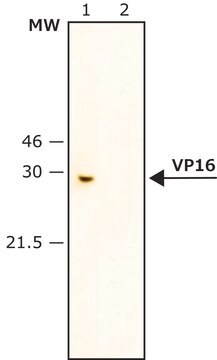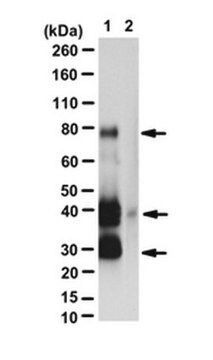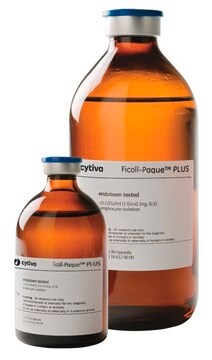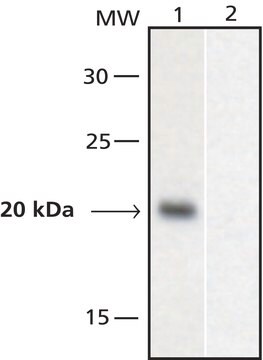Alle Fotos(1)
Wichtige Dokumente
G3042
Anti-GAL4 DNA-BD antibody produced in rabbit
affinity isolated antibody, buffered aqueous solution
Synonym(e):
Anti-Galactose 4 DNA Binding Domain
Anmeldenzur Ansicht organisationsspezifischer und vertraglich vereinbarter Preise
Alle Fotos(1)
About This Item
Empfohlene Produkte
Biologische Quelle
rabbit
Qualitätsniveau
Konjugat
unconjugated
Antikörperform
affinity isolated antibody
Antikörper-Produkttyp
primary antibodies
Klon
polyclonal
Form
buffered aqueous solution
Methode(n)
western blot: 1-2 μg/mL using GAL4 (DBD 1-147) fusion protein
Versandbedingung
dry ice
Lagertemp.
−20°C
Posttranslationale Modifikation Target
unmodified
Allgemeine Beschreibung
The polyclonal Anti-GAL4 DNA-BD rabbit antibody is a synthetic peptide that recognizes GAL4 DNA binding domain fusion proteins. GAL4 protein is an 881 amino acid transcription factor. It contains functionally independent N-terminal DNA binding (147 amino acids) and C-terminal activator domains. It is a constituent of yeast two hybrid system, where GAL 4 DNA-BD is fused to protein X (bait) and GAL4 activation domain is fused to protein Y (prey).
Spezifität
Anti-GAL4 DNA-BD recognizes GAL4 DNA binding domain fusion proteins.
Immunogen
synthetic peptide corresponding to the Saccharomyces cerevisiae GAL4 protein DNA binding domain (amino acids 39-52).
Anwendung
Anti-GAL4 DNA-BD antibody produced in rabbit has been used in western blotting.
Biochem./physiol. Wirkung
GAL4 transcription factor is involved in the induction of genes that regulate galactose metabolism in Saccharomyces cerevisiae. The yeast two hybrid system is widely used for the characterization of domains that are necessary and sufficient for the interaction of two known proteins by deletion and mutational analysis.
Physikalische Form
Solution in 0.01 M phosphate buffered saline, pH 7.4, containing 1% bovine serum albumin and 15 mM sodium azide.
Lagerung und Haltbarkeit
For continuous use store at 2-8°C for up to one month. For extended storage, freeze in working aliquots at –20 °C. Repeated freezing and thawing, or storage in “frost-free” freezers, is not recommended. If slight turbidity occurs upon prolonged storage, clarify the solution by centrifugation before use. Working dilution samples should be discarded if not used within 12 hours.
Haftungsausschluss
Unless otherwise stated in our catalog, our products are intended for research use only and are not to be used for any other purpose, which includes but is not limited to, unauthorized commercial uses, in vitro diagnostic uses, ex vivo or in vivo therapeutic uses or any type of consumption or application to humans or animals.
Sie haben nicht das passende Produkt gefunden?
Probieren Sie unser Produkt-Auswahlhilfe. aus.
Lagerklassenschlüssel
12 - Non Combustible Liquids
WGK
nwg
Flammpunkt (°F)
Not applicable
Flammpunkt (°C)
Not applicable
Hier finden Sie alle aktuellen Versionen:
Besitzen Sie dieses Produkt bereits?
In der Dokumentenbibliothek finden Sie die Dokumentation zu den Produkten, die Sie kürzlich erworben haben.
Sirtuin 7-dependent deacetylation of DDB1 regulates the expression of nuclear receptor TR4
Karim Mdf, et al.
Biochemical and biophysical research communications, 490(2), 423-428 (2017)
The putative SWI/SNF complex subunit BRAHMA activates flower homeotic genes in Arabidopsis thaliana.
Lidia Hurtado et al.
Plant molecular biology, 62(1-2), 291-304 (2006-07-18)
Arabidopsis thaliana BRAHMA (BRM, also called AtBRM) is a SNF2 family protein homolog of Brahma, the ATPase of the Drosophila SWI/SNF complex involved in chromatin remodeling during transcription. Here we show that, in contrast to its Drosophila counterpart, BRM is
Yukiko Imai et al.
Chromosoma, 126(6), 681-695 (2017-05-21)
PR domain-containing protein 9 (PRDM9) is a major regulator of the localization of meiotic recombination hotspots in the human and mouse genomes. This role involves its DNA-binding domain, which is composed of a tandem array of zinc fingers, and PRDM9-dependent
Mitsuki Uemura et al.
Veterinary and comparative oncology, 18(2), 247-255 (2019-09-14)
RAD51 forms a complex with BRCA2 and plays a central role in the DNA damage response pathway that is associated with homologous recombination. The structures of RAD51 and its homologues are highly conserved from prokaryotes to higher eukaryotes. Although a
X Wang et al.
Oncogene, 27(13), 1894-1904 (2007-10-02)
As a cyclin-dependent kinase inhibitor, p16(INK4a) plays a key role in cell cycle progression and cellular differentiation, and its expression is frequently altered in human cancers through epigenetically mediated transcriptional silencing. In this report, we demonstrate that p300 was able
Unser Team von Wissenschaftlern verfügt über Erfahrung in allen Forschungsbereichen einschließlich Life Science, Materialwissenschaften, chemischer Synthese, Chromatographie, Analytik und vielen mehr..
Setzen Sie sich mit dem technischen Dienst in Verbindung.








